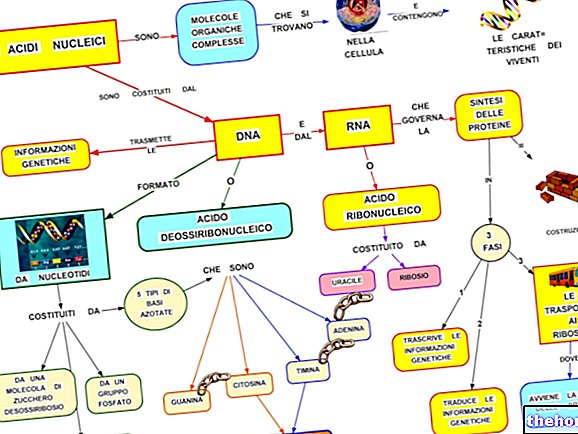Generality
The classification of bacterial species into aerobic and anaerobic bacteria is made according to the energy source used to feed the biosynthetic processes of their metabolism.

Based on this type of classification, the various bacterial species can be divided into four large groups.
Obligate aerobes
Bacteria belonging to this group draw energy from aerobic breathing; therefore, they absolutely need oxygen (O2) to survive.
Obligate anaerobes
Obligate anaerobes - also known as aerophobes - they are bacteria that do not need O2 to survive, but, on the contrary, the presence of oxygen in their habitat inhibits their growth.
These bacteria draw energy from other metabolic processes, such as fermentation, the anaerobic respiration, the bacterial photosynthesis or the methanogenesis.
Facultative aerobes / anaerobes
For the growth of bacteria belonging to this group, oxygen is not essential, but when it is available, it is still used.
These microorganisms, in fact, in anaerobic conditions (absence of O2) draw energy from processes such as fermentation or the anaerobic respiration, while in the presence of oxygen (aerobic conditions) they produce energy through the aerobic breathing.
Aerotolerant anaerobes
These bacteria produce energy exclusively through anaerobic processes (generally, through the fermentation), but - contrary to what happens for obligate anaerobes - the presence of oxygen in their habitat does not inhibit their growth.
The type of behavior that a bacterium has towards oxygen depends on the type of enzymes that the bacterium itself possesses. More specifically, it depends on the enzymes capable of interacting with oxygen and its radicals, such as the superoxide anion ( O2-), hydroxyl radicals (• OH) and hydrogen peroxide (H2O2).
These enzymes are:
- Superoxide dismutase, is an enzyme present in obligate aerobes, in aerotolerant anaerobes and in many facultative aerobes. Its job is to prevent superoxide buildup which would otherwise be lethal to the cell.
- Catalase, is an enzyme present in obligate aerobes and in many facultative aerobes. Its job is to break down hydrogen peroxide (H2O2) into water (H2O) and oxygen (O2). In this way, the enzyme detoxifies the bacterial cell of this extremely harmful component.
- Peroxidase, is an enzyme present in many aerotolerant anaerobes. Its job is to convert hydrogen peroxide (H2O2) into water (H2O) through an electron transfer mechanism.
Obligate anaerobes do not have these enzymes, which is why the presence of oxygen in their habitat inhibits their growth.
Oxygen radicals are formed as waste products of metabolic processes, both of prokaryotic cells (such as bacterial ones) and of eukaryotic cells (such as animal and plant cells). These radicals are harmful to the cell and must be immediately degraded to prevent them from exerting their toxic action. Therefore, only bacteria that possess the enzymes responsible for the degradation of oxygen radicals can survive and grow in aerobic conditions.
Photosynthetic organisms (such as plants, algae and some bacterial species) and also some non-photosynthetic organisms are able to protect themselves from the action of O2 radicals thanks to the presence of particular pigments, carotenoids. These pigments, in fact, are able to neutralize toxic oxygen radicals, protecting the cell from oxidative mechanisms.
Aerobic and pathogenic anaerobic bacteria
Some of the main aerobic and anaerobic bacteria that can be pathogenic to humans will be briefly described below.
Human pathogenic obligate aerobes
There are many bacterial species pathogenic to humans that belong to this group, among which, we remember:
- Bordatella pertussis, responsible for respiratory tract infections that cause pertussis or acute bronchitis. The therapy of first choice against infections from B. pertussis provides for the use of erythromycin (a macrolide); alternatively, amoxicillin can be used. A vaccine is also available to prevent this type of infection.
- Legionella pneumophila, responsible for the onset of legionnaires' disease (or legionellosis). Legionellosis can be treated with drugs such as azithromycin, erythromycin, clarithromycin, telithromycin or fluoroquinolones.
- Mycobacterium leprae, is responsible for the onset of leprosy. To counter the infections caused by this microorganism, combinations of drugs such as dapsone and rifampicin or acedapsone and clofazimine are used.
- Neisseria gonorrhoeae, is responsible for the onset of pharyngeal gonorrhea, gonorrhea, acute gonococcal urethritis, prostatitis, cervicitis, endometritis, pelvic inflammatory disease, dermatitis and arthritis. To treat infections from N. gonorrhoeae cephalosporins (such as ceftriaxone and cefixime) or fluoroquinolones are usually used.
Human pathogenic obligate anaerobes
Among the various pathogenic bacteria for humans that can grow only in oxygen-free habitats - therefore in anaerobic conditions - we remember:
- Clostridium difficile, this bacteria can be part of the normal human bacterial flora and is responsible for opportunistic infections of the gastrointestinal tract. Against infections from C. difficultantibiotics such as metronidazole, chloramphenicol, vancomycin or erythromycin are usually used.
- Clostridium tetani, responsible of tetanus (or spastic paralysis). Generally, metronidazole or benzylpenicillin are used against this beating. A vaccine is also available to prevent infection.
- Clostridium botulinum, responsible of botulism (or flaccid paralysis).
- Bacterioides fragilis, is responsible for the onset of abdominal abscesses, appendicitis, peritonitis, rectal abscess or septicemia. To treat infections from B. fragilis antibiotics such as metronidazole, clindamycin or carbapenems are used.
Facultative aerobes / anaerobes pathogenic to humans
Among the facultative aerobes / anaerobes that can be pathogenic for humans, we remember:
- Escherichia coli, is a bacteria normally present in the human intestinal bacterial flora, but in immunosuppressed subjects it can give rise to opportunistic infections that can cause urethrocystitis, prostatitis, neonatal meningitis, enterohemorrhagic colitis, watery diarrhea or traveler's diarrhea.
The most commonly used antibiotics to treat E. coli they are carbapenems, penicillins, monobactams, aminoglycosides, cephalosporins or macrolides. - Haemophilus influenzae, is responsible for infections of the respiratory tract and nervous system. The antibiotics usually used to fight the infections caused by this bacteria are cephalosporins, penicillins or sulfonamides.
Pathogenic aerotolerant anaerobes for humans
Among the various pathogenic bacteria belonging to this group, we remember the Propionibacterium acnes and the Propionibacterium propionicum.
The P. acnes it is part of the normal bacterial flora present on human skin and is involved in the development of acne. In some cases, however, the P. acnes it can cause opportunistic infections leading to meningitis, endocarditis, arthritis or surgical infections.
The P. propionicum instead, it is responsible for the onset of lacrimal canaliculitis and dental abscesses.
Drugs such as penicillins, cephalosporins, quinolones or vancomycin can be used to treat infections caused by this type of bacteria.
Prevention of bacterial infections
Bacteria are microorganisms present everywhere, with which we come into contact on a daily basis. Some of these microorganisms are harmless to our body, some are useful, while others can be very dangerous.
Generally, a few simple precautions are enough to prevent bacterial infections, such as, for example:
- Wash your hands thoroughly and thoroughly before starting to cook, eat or after touching objects that can be a vehicle for bacterial spread;
- Follow basic hygiene rules when storing, preparing or cooking food.
However, simply adhering to hygiene rules is not always sufficient to prevent bacterial infections.
To prevent sexually transmitted bacterial infections, for example, the use of barrier methods of contraception (such as condoms) is essential.
For the prevention of some types of bacterial infections, sometimes potentially fatal, vaccines are also available (an example could be that of tetanus vaccination).
Finally, the role of each individual's immune system should also not be underestimated. A functioning immune system can sometimes be sufficient to prevent the development of many bacterial infections.









.jpg)


















